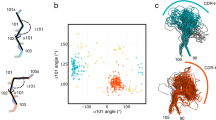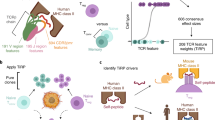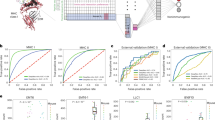Abstract
The T cell antigen receptor (TCR)–peptide–major histocompatibility complex (MHC) interface is composed of conserved and diverse regions, yet the relative contribution of each in shaping recognition by T cells remains unclear. Here we isolated cross-reactive peptides with limited homology, which allowed us to compare the structural properties of nine peptides for a single TCR-MHC pair. The TCR's cross-reactivity was rooted in highly similar recognition of an apical 'hot-spot' position in the peptide with tolerance of sequence variation at ancillary positions. Furthermore, we found a striking structural convergence onto a germline-mediated interaction between the TCR CDR1α region and the MHC α2 helix in twelve TCR-peptide-MHC complexes. Our studies suggest that TCR-MHC germline-mediated constraints, together with a focus on a small peptide hot spot, might place limits on peptide antigen cross-reactivity.
This is a preview of subscription content, access via your institution
Access options
Subscribe to this journal
Receive 12 print issues and online access
$209.00 per year
only $17.42 per issue
Buy this article
- Purchase on Springer Link
- Instant access to full article PDF
Prices may be subject to local taxes which are calculated during checkout




Similar content being viewed by others
References
Adams, J.J. et al. T cell receptor signaling is limited by docking geometry to peptide-major histocompatibility complex. Immunity 35, 681–693 (2011).
Rossjohn, J. et al. T cell antigen receptor recognition of antigen-presenting molecules. Annu. Rev. Immunol. 33, 169–200 (2015).
Beringer, D.X. et al. T cell receptor reversed polarity recognition of a self-antigen major histocompatibility complex. Nat. Immunol. 16, 1153–1161 (2015).
Dai, S. et al. Crossreactive T cells spotlight the germline rules for αβ T cell-receptor interactions with MHC molecules. Immunity 28, 324–334 (2008).
Feng, D., Bond, C.J., Ely, L.K., Maynard, J. & Garcia, K.C. Structural evidence for a germline-encoded T cell receptor-major histocompatibility complex interaction 'codon'. Nat. Immunol. 8, 975–983 (2007).
Garcia, K.C., Adams, J.J., Feng, D. & Ely, L.K. The molecular basis of TCR germline bias for MHC is surprisingly simple. Nat. Immunol. 10, 143–147 (2009).
Marrack, P., Scott-Browne, J.P., Dai, S., Gapin, L. & Kappler, J.W. Evolutionarily conserved amino acids that control TCR-MHC interaction. Annu. Rev. Immunol. 26, 171–203 (2008).
Rangarajan, S. & Mariuzza, R.A. T cell receptor bias for MHC: co-evolution or co-receptors? Cell. Mol. Life Sci. 71, 3059–3068 (2014).
Scott-Browne, J.P., White, J., Kappler, J.W., Gapin, L. & Marrack, P. Germline-encoded amino acids in the αβ T-cell receptor control thymic selection. Nature 458, 1043–1046 (2009).
Van Laethem, F., Tikhonova, A.N. & Singer, A. MHC restriction is imposed on a diverse T cell receptor repertoire by CD4 and CD8 co-receptors during thymic selection. Trends Immunol. 33, 437–441 (2012).
Borbulevych, O.Y., Santhanagopolan, S.M., Hossain, M. & Baker, B.M. TCRs used in cancer gene therapy cross-react with MART-1/Melan-A tumor antigens via distinct mechanisms. J. Immunol. 187, 2453–2463 (2011).
Colf, L.A. et al. How a single T cell receptor recognizes both self and foreign MHC. Cell 129, 135–146 (2007).
Yin, L. et al. A single T cell receptor bound to major histocompatibility complex class I and class II glycoproteins reveals switchable TCR conformers. Immunity 35, 23–33 (2011).
Stadinski, B.D. et al. A role for differential variable gene pairing in creating T cell receptors specific for unique major histocompatibility ligands. Immunity 35, 694–704 (2011).
Borbulevych, O.Y. et al. T cell receptor cross-reactivity directed by antigen-dependent tuning of peptide-MHC molecular flexibility. Immunity 31, 885–896 (2009).
Burrows, S.R. et al. Hard wiring of T cell receptor specificity for the major histocompatibility complex is underpinned by TCR adaptability. Proc. Natl. Acad. Sci. USA 107, 10608–10613 (2010).
Degano, M. et al. A functional hot spot for antigen recognition in a superagonist TCR/MHC complex. Immunity 12, 251–261 (2000).
Ding, Y.H., Baker, B.M., Garboczi, D.N., Biddison, W.E. & Wiley, D.C. Four A6-TCR/peptide/HLA-A2 structures that generate very different T cell signals are nearly identical. Immunity 11, 45–56 (1999).
Garcia, K.C. et al. Structural basis of plasticity in T cell receptor recognition of a self peptide-MHC antigen. Science 279, 1166–1172 (1998).
Garcia, K.C. et al. An ab T cell receptor structure at 2.5Å and its orientation in the TCR-MHC complex. Science 274, 209–219 (1996).
Huseby, E.S. et al. How the T cell repertoire becomes peptide and MHC specific. Cell 122, 247–260 (2005).
Liu, Y.C. et al. Highly divergent T-cell receptor binding modes underlie specific recognition of a bulged viral peptide bound to a human leukocyte antigen class I molecule. J. Biol. Chem. 288, 15442–15454 (2013).
Mazza, C. et al. How much can a T-cell antigen receptor adapt to structurally distinct antigenic peptides? EMBO J. 26, 1972–1983 (2007).
Piepenbrink, K.H., Blevins, S.J., Scott, D.R. & Baker, B.M. The basis for limited specificity and MHC restriction in a T cell receptor interface. Nat. Commun. 4, 1948 (2013).
Yin, Y., Wang, X.X. & Mariuzza, R.A. Crystal structure of a complete ternary complex of T-cell receptor, peptide-MHC, and CD4. Proc. Natl. Acad. Sci. USA 109, 5405–5410 (2012).
Correia-Neves, M., Waltzinger, C., Mathis, D. & Benoist, C. The shaping of the T cell repertoire. Immunity 14, 21–32 (2001).
Starr, T.K., Jameson, S.C. & Hogquist, K.A. Positive and negative selection of T cells. Annu. Rev. Immunol. 21, 139–176 (2003).
Alajez, N.M., Schmielau, J., Alter, M.D., Cascio, M. & Finn, O.J. Therapeutic potential of a tumor-specific, MHC-unrestricted T-cell receptor expressed on effector cells of the innate and the adaptive immune system through bone marrow transduction and immune reconstitution. Blood 105, 4583–4589 (2005).
Van Laethem, F. et al. Deletion of CD4 and CD8 coreceptors permits generation of αβ T cells that recognize antigens independently of the MHC. Immunity 27, 735–750 (2007).
Birnbaum, M.E. et al. Deconstructing the peptide-MHC specificity of T cell recognition. Cell 157, 1073–1087 (2014).
Sewell, A.K. Why must T cells be cross-reactive? Nat. Rev. Immunol. 12, 669–677 (2012).
Wooldridge, L. et al. A single autoimmune T cell receptor recognizes more than a million different peptides. J. Biol. Chem. 287, 1168–1177 (2012).
Felix, N.J. et al. Alloreactive T cells respond specifically to multiple distinct peptide-MHC complexes. Nat. Immunol. 8, 388–397 (2007).
Jones, L.L. et al. Engineering and characterization of a stabilized α1/α2 module of the class I major histocompatibility complex product Ld. J. Biol. Chem. 281, 25734–25744 (2006).
Mitaksov, V. et al. Structural engineering of pMHC reagents for T cell vaccines and diagnostics. Chem. Biol. 14, 909–922 (2007).
Udaka, K. et al. An automated prediction of MHC class I-binding peptides based on positional scanning with peptide libraries. Immunogenetics 51, 816–828 (2000).
Jones, L.L., Colf, L.A., Stone, J.D., Garcia, K.C. & Kranz, D.M. Distinct CDR3 conformations in TCRs determine the level of cross-reactivity for diverse antigens, but not the docking orientation. J. Immunol. 181, 6255–6264 (2008).
Mason, D. A very high level of crossreactivity is an essential feature of the T-cell receptor. Immunol. Today 19, 395–404 (1998).
Maynard, J. et al. Structure of an autoimmune T cell receptor complexed with class II peptide-MHC: insights into MHC bias and antigen specificity. Immunity 22, 81–92 (2005).
Pinilla, C. et al. Exploring immunological specificity using synthetic peptide combinatorial libraries. Curr. Opin. Immunol. 11, 193–202 (1999).
Wilson, D.B. et al. Specificity and degeneracy of T cells. Mol. Immunol. 40, 1047–1055 (2004).
Bogan, A.A. & Thorn, K.S. Anatomy of hot spots in protein interfaces. J. Mol. Biol. 280, 1–9 (1998).
Gagnon, S.J. et al. Unraveling a hotspot for TCR recognition on HLA-A2: evidence against the existence of peptide-independent TCR binding determinants. J. Mol. Biol. 353, 556–573 (2005).
Yokosuka, T. et al. Predominant role of T cell receptor (TCR)-α chain in forming preimmune TCR repertoire revealed by clonal TCR reconstitution system. J. Exp. Med. 195, 991–1001 (2002).
Tynan, F.E. et al. T cell receptor recognition of a 'super-bulged' major histocompatibility complex class I-bound peptide. Nat. Immunol. 6, 1114–1122 (2005).
Deng, L., Langley, R.J., Wang, Q., Topalian, S.L. & Mariuzza, R.A. Structural insights into the editing of germ-line-encoded interactions between T-cell receptor and MHC class II by Vα CDR3. Proc. Natl. Acad. Sci. USA 109, 14960–14965 (2012).
Tikhonova, A.N. et al. αβ T cell receptors that do not undergo major histocompatibility complex-specific thymic selection possess antibody-like recognition specificities. Immunity 36, 79–91 (2012).
Leslie, A.G.W . & Powell, H.R. in Evolving Methods for Macromolecular Crystallography Vol. 245 (eds. Read, R.J. & Sussman, J.L.) 41–51 (Springer, 2007).
Evans, P. Scaling and assessment of data quality. Acta Crystallogr. D 62, 72–82 (2006).
Otwinowski, Z. & Minor, W. in Methods in Enzymology Vol. (eds. Carter, C.W. Jr. & Sweet, R.M.) 276, 307–326 (1997).
McCoy, A.J. Solving structures of protein complexes by molecular replacement with Phaser. Acta Crystallogr. D Biol. Crystallogr. 63, 32–41 (2007).
Adams, P.D. et al. PHENIX: a comprehensive Python-based system for macromolecular structure solution. Acta Crystallogr. D Biol. Crystallogr. 66, 213–221 (2010).
Emsley, P. & Cowtan, K. Coot: model-building tools for molecular graphics. Acta Crystallogr. D Biol. Crystallogr. 60, 2126–2132 (2004).
The PyMOL Molecular Graphics System, Version 1.7.4 Schrödinger, LLC.
Acknowledgements
We thank S. O'Herrin (Ben May Institute for Cancer Research) for the 58α−/β− cell line; J.M. Connolly (Washington University School of Medicine) for the LM1.8-H-2LdW97R cell line; and N. Goriatcheva, E. Özkan, D.Wittrup, E. Newell, N. Jarvik and M. McLaughlin for discussions. Supported by the Canadian Institutes of Health Research (J.J.A.), the National Science Foundation (M.E.B.), the US National Institutes of Health (AI103867, AI045757 and AI057229 to K.C.G., and GM55767 to D.M.K.), the Jordan family, and the Howard Hughes Medical Institute (K.C.G.). Use of the Stanford Synchrotron Radiation Lightsource, SLAC National Accelerator Laboratory, is supported by the US Department of Energy, Office of Science, Office of Basic Energy Sciences under contract number DE-AC02-76SF00515. The SSRL Structural Molecular Biology Program is supported by the Department of Energy Office of Biological and Environmental Research and by the US National Institutes of Health, National Institute of General Medical Sciences (including P41GM103393).
Author information
Authors and Affiliations
Contributions
J.J.A., S.N., M.E.B., D.M.K. and K.C.G. conceived of the project; J.J.A., S.N., and M.E.B. performed experiments and analyzed data; and all authors interpreted data, developed the concepts in the manuscript, and wrote and edited the manuscript.
Corresponding author
Ethics declarations
Competing interests
The authors declare no competing financial interests.
Integrated supplementary information
Supplementary Figure 1 Evolution of a second-generation H-2Ld scaffold.
(a) The protein architecture of the single chain m31r-CP template used for error prone PCR. (b) The enrichment of gain-of-function mutations in yeast scaffolds, during rounds of selections using TCR-tetramers. (c) The gain-of-function mutations that provided the brightest 2C-tetramer and 42F3-tetramer staining on the clonal yeast population m31r-CP-E3. Inset is the zoomed in depiction of the peptide linker-MHC-junctions and proximal selected mutations (sticks). (d) Mutations in the m31s-W167A used to display the C-terminally linked peptide libraries. (e) Staining of 96 clonal yeast populations isolated from the final round of selection for the 42F3 TCR. (f) The unique peptide sequences selected by 42F3 TCR observed in the sequencing sample. The P2 and P9 positions with restricted diversity are highlighted in black and blue respectively, and positions fully diversified are highlighted in red.
Supplementary Figure 2 Peptide dose response for the activation of 42F3 T cells.
Peptide dose response of IL-2 release for 42F3 T cells, separated into ‘full agonist’ (a) and ‘partial agonist’ (b) groups. Data is represented as mean ± s.e.m., n=2 of technical replicates.
Supplementary Figure 3 Binding kinetics of 42F3 TCR–agonistic peptide–MHC.
(a) The surface plasmon traces and steady-state fits (inset) for agonist peptide-MHC binding to the 42F3 TCR analyte. (b) The surface plasmon traces and kinetic fits for agonist peptide-MHC binding 42F3 TCR. (c) A kinetic summary for each peptide-MHC-TCR complex.
Supplementary Figure 4 Structures of 42F3 TCR–agonistic peptides.
(a) The overall structure of the 42F3 complex recognizing second-generation synthetic peptides presented by mini-H-2Ld. (b) The 2Fo-Fc map of peptides (yellow sticks) in electron density (blue mesh) contoured for 1-1.5σ. (c) The overall structure of the 42F3 complex recognizing first-generation synthetic peptides presented by mini-H-2Ld. (d) The 2Fo-Fc map of peptides (yellow sticks) in electron density (blue mesh) is contoured for 1-1.5σ.
Supplementary Figure 5 The conserved germline contacts of the 42F3 TCR to the MHC.
(a) Structures of the Vα3.3 contacts to the α2 domain of H-2Ld for five second-generation agonist complexes. (b) Structures of the Vβ8.3 contacts to the α1 domain of H-2Ld for five second-generation agonist complexes. The MHC is colored green, Vα is colored red, and the Vβ is colored blue. Contact residues are depicted as sticks where dashed lines represent hydrogen bonds.
Supplementary information
Supplementary Text and Figures
Supplementary Figures 1–5 and Supplementary Tables 1 and 2 (PDF 1443 kb)
Source data
Rights and permissions
About this article
Cite this article
Adams, J., Narayanan, S., Birnbaum, M. et al. Structural interplay between germline interactions and adaptive recognition determines the bandwidth of TCR-peptide-MHC cross-reactivity. Nat Immunol 17, 87–94 (2016). https://doi.org/10.1038/ni.3310
Received:
Accepted:
Published:
Issue Date:
DOI: https://doi.org/10.1038/ni.3310
This article is cited by
-
T cell receptor therapeutics: immunological targeting of the intracellular cancer proteome
Nature Reviews Drug Discovery (2023)
-
Validation and promise of a TCR mimic antibody for cancer immunotherapy of hepatocellular carcinoma
Scientific Reports (2022)
-
Structural basis for oligoclonal T cell recognition of a shared p53 cancer neoantigen
Nature Communications (2020)
-
Deciphering CD4+ T cell specificity using novel MHC–TCR chimeric receptors
Nature Immunology (2019)
-
The evolving landscape of biomarkers for checkpoint inhibitor immunotherapy
Nature Reviews Cancer (2019)



